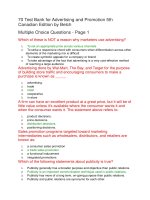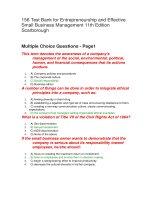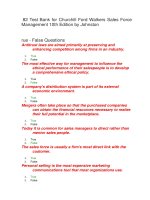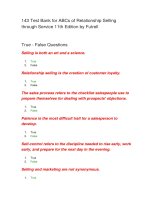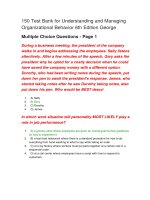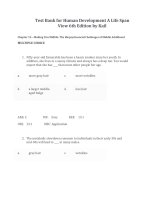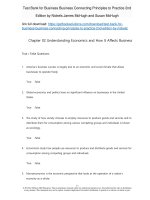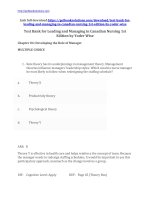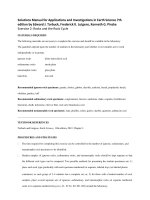Test bank for leading and managing in canadian nursing 1st edition by yoder wise
Bạn đang xem bản rút gọn của tài liệu. Xem và tải ngay bản đầy đủ của tài liệu tại đây (566.24 KB, 22 trang )
Link full download: />
Test Bank for Leading and Managing in Canadian Nursing 1st
Edition by Yoder Wise
Chapter 04: Developing the Role of Manager
MULTIPLE CHOICE
1. Role theory has its underpinnings in management theory. Management
theories influence managers’ leadership styles. Which would a nurse manager
be most likely to follow when redesigning the staffing schedule?
a.
Theory X
b.
Productivity theory
c.
Psychological theory
d.
Theory Y
ANS: D
Theory Y is effective in health care and helps reinforce the concept of team. Because
the manager needs to redesign staffing schedules, it would be important to use this
participatory approach, inasmuch as the change involves a group.
DIF: Cognitive Level: Apply
REF: Page 65 (Theory Box)
TOP: Nursing Process: Planning
2. A nurse manager has worked rapidly to persuade the staff to accept changes
in the unit’s mission, so that downsizing can be avoided, through innovative
use of technology. This nurse manager is displaying
a.
a focus on past concerns related to the mission.
b.
how to teach staff members about self-management.
c.
facilitation of goal accomplishment.
d.
a requirement that all staff members need to review
and reinforce their technologic skills.
ANS: C
Nurse managers who are successful in motivating staff provide a work environment
that facilitates goal accomplishment and personal satisfaction. In this situation, the
nurse manager worked quickly to avoid downsizing, thus facilitating the goal of
avoiding staff layoffs.
DIF: Cognitive Level: Analyze
REF: Page 57 | Page 65
TOP: Nursing Process: Implementation
3. The nurse manager, as the leader of the unit’s “customer (patient) first”
initiative, has asked the staff nurses to develop and administer a survey to
every patient before discharge. In asking the staff nurses to accomplish this
task, the nurse manager is demonstrating
a.
accountability.
b.
shared governance.
c.
a common purpose.
d.
independence in the nursing manager’s role.
ANS: B
Engaging staff and others in decision-making and in obtaining information is one
characteristic of creating a shared governance structure in which nurses are
encouraged to make decisions.
DIF: Cognitive Level: Apply
REF: Page 57
TOP: Nursing Process: Implementation
4. A nurse manager is encountering considerable conflict among staff members
because of weekend staffing coverage. During a called staff meeting, the nurse
manager asks the disgruntled staff to meet as a group and determine the best
staffing practices. In doing this, the nurse manager is using the concept of
collaboration to
a.
demonstrate interdependence.
b.
depict flexibility and broadmindedness.
c.
focus all energies of staff members on a win-win
strategy.
d.
defuse the possibility that staff members’ discontent
will escalate when staffing the unit on weekends.
ANS: C
Conflict resolution skills are important for nursing managers. When collaboration is
used to solve a conflict, all energies are focused on solving the problem, rather than
on defeating other people with opposing views.
DIF: Cognitive Level: Analyze
REF: Page 58 | Page 61
TOP: Nursing Process: Implementation
5. A nurse manager’s responsibility for financial management involves making
budgetary decisions. Budgets that enable the nurse manager to allocate
resources at the unit level allow
a.
minimal nurse manager input.
b.
limited rationale for budgetary requests.
c.
budgetary allocations at the executive nurse level.
d.
budgetary decision making at the point of service.
ANS: D
In organizational structures in which decision-making occurs at the point of service,
nurse managers are given responsibility for preparing and implementing a budget
that meets the long- and short-term needs of their unit without requiring
hierarchical approval.
DIF: Cognitive Level: Understand
Planning
REF: Page 63
TOP: Nursing Process:
6. Which represents one of the Canadian Nurses Association’s top six
competencies of a good nurse manager?
a.
Political activism
b.
Conflict resolution skills
c.
Budgetary responsibility
d.
Current clinical practice knowledge
ANS: B
The top six competencies for nurse managers are (1) accountability for professional
practice, (2) verbal communication, (3) team-building skills, (4) leadership skills,
(5) conflict resolution, and (6) knowledge of ethical and legal issues.
DIF: Cognitive Level: Understand
REF: Page 58
TOP: Nursing Process: Assessment
7. Whenever a staff nurse asks Sue, the nursing manager, about the best way to
perform a new procedure, Sue immediately goes to the computer with the
staff nurse and searches for online best practices related to the procedure in
question. What is Sue demonstrating?
a.
Lack of procedural knowledge
b.
Role-modelling evidence-informed decision-making
c.
Empowerment for the staff nurse to do this on her
own, rather than involve the manager
d.
The key role of informatics in the current health care
system
ANS: B
Nurse managers can help staff use research evidence in their practice decisionmaking by valuing research, role modelling, providing encouragement, ensuring
policies are based on research and are up to date, and monitoring practice and
patient outcomes.
DIF: Cognitive Level: Apply
REF: Page 58
TOP: Nursing Process: Implementation
8. In planning a new wing, the nurse manager complies with the workplace
safety requirements of the U.S. Occupational Safety and Health
Administration (OSHA). Which of the following groups is considered to be at
high risk for violence in the workplace?
a.
Pediatric staff
b.
Postsurgical unit staff
c.
Emergency department staff
d.
Medical oncology unit staff
ANS: C
Emergency department staff members are considered to be at high risk for violence.
DIF: Cognitive Level: Remember
Planning
REF: Page 60
TOP: Nursing Process:
9. In orienting a 25-year-old nurse, the unit manager understands that this
worker probably
a.
likes to attend to detail.
b.
is highly proficient in math and reading skills.
c.
enjoys being managed by superiors.
d.
likes to solve problems without being given solutions.
ANS: D
A role of the manager is to understand various motivations of staff and to bring
these together in the accomplishment of goals. In general, younger workers are
motivated strongly by shared governance and decision-making.
DIF: Cognitive Level: Understand
Planning
REF: Page 57
TOP: Nursing Process:
10. Nurses on Unit 4 are unhappy and frustrated with their nurse manager. They
complain that “nothing is ever good enough for him.” Such statements suggest
that the nurse manager’s goals may be
a.
measurable.
b.
unrealistic.
c.
attainable.
d.
too low.
ANS: B
Nurse managers need to set goals that are high enough to achieve excellence but
reasonable enough to enable achievement. Lack of achievement can result in
frustration.
DIF: Cognitive Level: Analyze
REF: Page 56 | Page 62
TOP: Nursing Process: Evaluation
11. While interviewing for a nurse manager position, Ann is asked to give an
example of a situation in which she demonstrated leadership. Which of the
following examples exemplifies leadership?
a.
Through research and investigation of best practice
and practice-based evidence, she proposed a change
to management of incontinence in elderly patients.
b.
She ensured that new policies related to parenteral
infusions were implemented consistently within her
team.
c.
When asked by her students about institutional
policies, she readily and patiently interpreted policies
to facilitate quality care.
d.
She organized the team and delegated responsibilities
effectively in providing nursing care.
ANS: A
Management involves practising within and ensuring that established policies are
interpreted and followed accurately. Management is also concerned with
maximizing and coordinating resources to accomplish the vision of meeting
established goals and objectives. Leaders propose changes and inspire other people
to follow this vision.
DIF: Cognitive Level: Analyze
REF: Pages 57-58
TOP: Nursing Process: Assessment
12. Budgeting and protection of revenues is a function of
a.
leadership.
b.
management.
c.
team leadership.
d.
followers.
ANS: B
Managers address complex issues such as planning, budgeting, and allocating
resources, whereas leaders address change.
DIF: Cognitive Level: Understand
REF: Page 57
TOP: Nursing Process: Assessment
13. Which of the following is important in a positive work environment?
a.
One-way communication
b.
Accountability and clarity of roles and responsibilities
c.
Hierarchical decision-making
d.
Challenge and striving for excellence
ANS: B
One of the six competencies of a good nursing manager is accountability for
professional practice; clarity of roles and responsibilities enhances accountability.
DIF: Cognitive Level: Understand
REF: Page 58 | Page 60 | Page 64
TOP: Nursing Process: Planning
14. As the manager of a unit with a high percentage of young professionals, you
increase job satisfaction among this young staff by
a.
providing high levels of job structure and task
orientation.
b.
developing schedules that are fair and observing
contractual obligations.
c.
utilizing skills in the staffing mix to optimize the
delivery of patient care.
d.
establishing opportunities to self-schedule.
ANS: D
A manager is challenged to motivate staff and increase organizational commitment
across different generations of workers. Carver and Candela’s (2008) findings
suggested that strategies such as shared governance and self-scheduling increase
satisfaction among younger staff.
DIF: Cognitive Level: Apply
REF: Page 57
TOP: Nursing Process: Implementation
15. On the first day of every month, the nursing manager on the surgical unit
posts a staff nurse’s name on the bulletin board with the caption “Look what
this great nurse did this month” and outlines nursing behaviours that were
displayed by that particular nurse. This is an example of
a.
negative reinforcement.
b.
valuing employees.
c.
obtaining evidence for performance appraisals.
d.
reinforcing the vision and goals of the organization.
ANS: B
Nurse managers must communicate their commitment so that staff members know
they are valued in accomplishing the work of the unit that furthers the mission of
the organization. One way of demonstrating that employees are valued is through
recognition. Recognizing staff’s efforts is part of effective management practices.
DIF: Cognitive Level: Apply
REF: Page 62
TOP: Nursing Process: Implementation
16. As a nurse manager, you determine that a shift in nursing care models might
decrease workplace violence. Members of the hospital administration are
reluctant to adopt this new approach to care. To leverage your ideas, you
a.
ask staff to send e-mails to administration members
encouraging consideration of your option.
b.
invite a senior member of administration to your staff
meeting, so you can tell him what you are planning.
c.
write a letter of complaint to a member of the
institutional board about the lack of openness of the
administration.
d.
identify influential members of your nurse manager
group with similar ideas and request an opportunity
to meet with administration members to discuss
options.
ANS: D
In addressing issues with higher administration, it is important to develop power
strategies such as seeking support from other influences in the organization.
DIF: Cognitive Level: Apply
REF: Page 60
TOP: Nursing Process: Implementation
17. During staff meetings, you make it a regular practice to encourage shared
problem solving and to recognize employees who go beyond basic roles and
responsibilities to contribute to a positive team environment and to quality
patient care. This practice exemplifies
a.
values-based management.
b.
shaping of workplace behaviour.
c.
cooperation and collaboration.
d.
recognition of institutional priorities.
ANS: A
Values-based management recognizes that commitment to the vision, mission, and
purpose of the organization is demonstrated in everyday behaviour and that
managers communicate their commitment to staff members by expressing the value
of their work in accomplishing the mission, purpose, and priorities of the institution.
DIF: Cognitive Level: Apply
REF: Pages 61-62
TOP: Nursing Process: Implementation
18. The successful integration of informatics into health care settings is key to
a.
quality decision-making and processes related to
management of resources.
b.
accessing current information about business
practices.
c.
leveraging ideas from other managers.
d.
speeding up calculations and decisions in budget
development.
ANS: A
The use of informatics to research evidence and alternative models of delivery, to
compare data and solutions with those of other managers, and to assist with
integrative functions that make budgeting more efficient is related to high quality of
decision-making and processes related to management of resources such as
revenues and personnel.
DIF: Cognitive Level: Understand
Planning
REF: Page 62
TOP: Nursing Process:
19. As a nurse manager, you embrace the usefulness of resources such as Smart
Bed. This behaviour is important in
a.
budget development.
b.
a manager’s role.
c.
succession planning.
d.
encouragement of staff members’ use of technology.
ANS: D
Advances in technology such as the Smart Bed facilitate effectiveness and efficiency
in care. By becoming an early adopter of technology, staff members, particularly
older staff, who may be less comfortable with technologic advances, are encouraged
to value its use in care delivery and management.
DIF: Cognitive Level: Understand
REF: Page 63
TOP: Nursing Process: Implementation
20. A manager who is concerned with ensuring that patients on her surgical unit
have the necessary information to make informed choices is
a.
practicing legal nursing care.
b.
demonstrating respect for patients’ rights.
c.
avoiding risks.
d.
probably experiencing issues with informed consent.
ANS: B
In advocating for informed consent, the nurse manager is modelling professionalism
and a professional philosophy that includes patient rights such as the right to
informed consent. Concern for this right is associated with safe, competent, and
ethical care.
DIF: Cognitive Level: Understand
Planning
REF: Page 64
TOP: Nursing Process:
21. The nurse manager plays a unique role in institutional management in that
the nurse manager
a.
encourages shared decision-making.
b.
models professional nursing behaviour.
c.
interprets health care trends and their effect on
revenues.
d.
coordinates care and allocates resources.
ANS: B
Encouragement of shared decision-making, coordination of resources, and interface
between internal and external factors and a unit are all associated with effective
management but could be performed by a manager from any discipline. The nurse
manager’s unique role is modelling professional behaviour.
DIF: Cognitive Level: Understand
REF: Page 64
TOP: Nursing Process: Implementation
22. In developing an orientation program, the hospital educator breaks essential
organizational information down into chunks, which she develops as online
modules. This is an application of which of Peter F. Drucker’s functions of
management?
a.
Establishment of goals and objectives
b.
Motivation and communication
c.
Analysis and interpretation of performance
d.
Organization of activities into manageable tasks
ANS: D
Organizing the information into online modules is an application of Drucker’s
organizational analysis and the division of activities, decisions, and relations into
manageable tasks.
DIF: Cognitive Level: Apply
REF: Page 56
TOP: Nursing Process: Implementation
23. Julia is a staff nurse who works on a rehabilitation unit. Julia tells you that the
assistants are experiencing difficulty with the new lift and wonders what your
thoughts on organizing an educational session would be. Julia is
a.
communicating a vision for safety.
b.
taking a risk in identifying the problem with safety.
c.
coordinating the development of knowledge and skills
necessary to use the lift.
d.
taking responsibility for identifying a safety concern
and conceding authority for solution to you.
ANS: D
Communication of a vision and risk taking are leader traits, whereas coordination is
a manager trait. Taking responsibility while conceding authority to the leader is
depicted in the example.
DIF: Cognitive Level: Apply
REF: Page 57
TOP: Nursing Process: Implementation
MULTIPLE RESPONSE
1. A nurse manager is discussing with unit staff the repeated lack of staff
compliance in documenting exercise activity for patients who have
undergone cardiac surgery. The unit’s licensed practical/vocational nurses
are responsible for ensuring that patients carry out the prescribed exercise
regimen and that the activity is documented. According to Drucker’s five basic
functions of a manager, which of the following are appropriate functions for
the nurse manager to use when addressing this situation? (Select all that
apply.)
a.
Divide the necessary activities into manageable tasks,
so that patients adhere to the exercise regimen.
b.
Establish objectives and goals for each area and
decide who is accountable for them.
c.
Allow patients to organize the activities.
d.
Engage in activities that motivate the health care
team, and communicate effectively with the
responsible staff members.
e.
Analyze, appraise, and interpret the performance of
responsible staff members, and communicate these
findings to staff management.
f.
Allow patients to establish objectives and goals.
ANS: A, B, D, E
Drucker’s five basic functions include division of work into tasks; development and
communication of goals and outcomes; motivation and communication; and
analysis, approval, and interpretation of staff performance.
DIF: Cognitive Level: Apply
REF: Page 56
TOP: Nursing Process: Implementation
Leading and Managing in Canadian Nursing: 1st Edition Test Bank – Yoder-Wise
